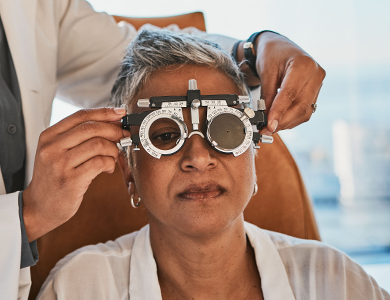
Dear
Telling low vision patients they can’t drive changes our patients lives dramatically. And, I don’t know anyone who enjoys doing that. What if I told you, that all you have to tell patients whose VA’s are 20/200 or better, is that you can refer them to a doctor who specializes in helping low vision patients improve the quality of their lives and “he can tell you if it is possible to help you drive safely”?
While it’s a routine assumption that a patient with minimum of 20/40 sight and full visual field (110 degrees to 140 degrees) has adequate vision for driving privileges and those who have worse VAs or visual fields don’t – low vision devices used properly can be a game changer. Please know that I will not authorize anyone to drive who is unsafe.
Every day I see low vision patients with 20/60 to 20/80 who say, “I want to see better to drive” as well as those who demand I just ‘sign the paper so I can drive’ who have VAs of 20/100 and 20/400. The patients who have 20/100 to 400, typically are scared there is nothing that can help them and they are hoping they can push their way through. Yet, I am still able to help some of them to be able to drive, while others I can at least improve the quality of their lives (with VAs less than 20/200).
Good cognitive skills and good reaction time are critical. As long as their VAs are 20/200 or better, I can help them to be able to drive safely. The only exception is Stargardt’s patients. For some reason, even if they are 20/400, the right bioptic telescopes can get them to 20/20.
Why refer for a low vision evaluation? For many of these patients, there is limited accessibility to get around. Our mass transit is nearly non-existent. Pay for rides is financially prohibitive. The family may be unavailable or greatly inconvenienced. As a result, their independence becomes threatened or impossible.
Rest assured that the Secretary of State, requires patents with bioptic telescopes to receive instruction and clearance from an Occupational Therapist. There really is an incredible system of professionals available to assure their safety as drivers. Fortunately, there is acceptable access to these occupational therapy services.
The power of these bioptics may range from 2.2X to 7.0x. All of my prescriptions for driving contain binocular solutions. Most providers dispense monocular options. The problem with monocular solutions is that the patient will close one eye in order not to see double. Obviously, this cuts the visual field dramatically. From a pragmatic standpoint, the weight will torque the spectacles to the telescopic mounted side which forces them to use the bifocal on the opposing side resulting in diplopia and blur.
Please know that there are thousands of patients that may still drive safely even though, with standard correction, they do not meet the “20/40” without telescopes! If I can be of assistance with a patient or you have any questions, please feel free to call my cell phone at: 734-536-5777.
Cordially,
John P. Jacobi, OD FCOVD, FIALVS
P.S. Low vision starts at 20/40





